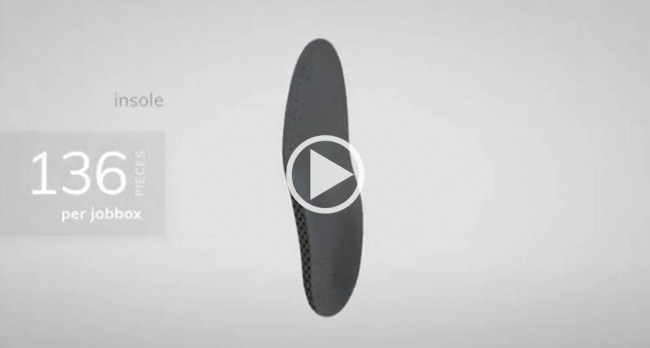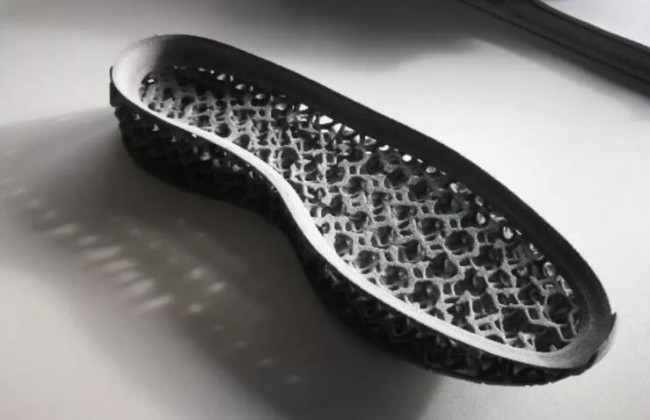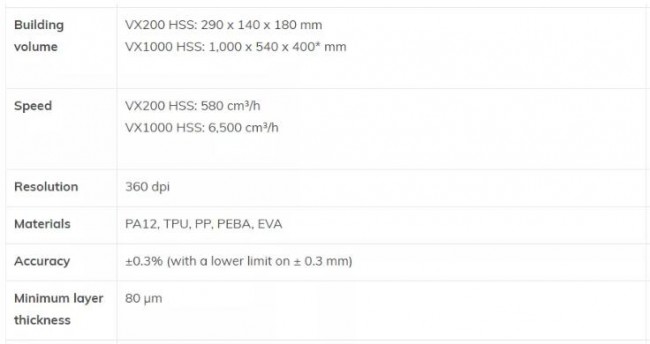Following the trend of lower prices and faster printing speeds, over the past few years,3D printingThe industry has seen many exciting new technologies that feature 100 times the current3D printingspeed will3D printingThe field of application of the technology cuts from prototyping to production.
German voxeljet, well-known in the industry for binder jetting, launched HSS-high-speed sintering equipment in 2017, which can be used for high-speed manufacturing of nylon or TPU materials.
 © VJ
© VJ
Break down barriers to collaboration between materials and equipment
![]() Economical mass production solutions
Economical mass production solutions
Materials companies Covestro and voxeljet-Voxeljet are collaborating to develop a material-equipment combination for economical large-scale series additive manufacturing, according to market insights from 3D Science Valley. With High Speed Sintering (HSS), voxeljet combines the advantages of two existing additive technologies: selective laser sintering and binder jetting to achieve the dual benefits of SLS part properties and the high productivity of binder jetting.
After co-development and qualification of thermoplastic polyurethane (TPU) powders for HSS, Covestro and voxeljet-Voxeljet are bringing their collaboration together by offering customers seamless material process solutions for volume manufacturing for their specific applications Take it to the next level.
Often materials and processing technology operate separately in the value chain, and it is up to the user to figure out how to make the two elements work together. Covestro and voxeljet are removing barriers to the adoption of AM-Additive Manufacturing on the production floor by breaking down barriers to collaboration between materials and equipment. Due to its large size and high speed capability, voxeljet’s HSS high-speed sintering technology provides manufacturers with an economical solution for mass production.
![]() A seamless combination of materials and craftsmanship
A seamless combination of materials and craftsmanship
voxeljet will combine Covestro’s expertise in functional material design through its large format VX1000 HSS printer to develop seamless material and process solutions for large-scale manufacturing.
The material currently under consideration by both parties is TPU, which is ideal for footwear and cushioning applications. Other materials include thermoplastic elastomers (TPE), polybutylene terephthalate (PBT) and polypropylene (PP).The advantage of the injection molding process lies in large batches, while3D printingThe advantage is in small batches or for very complex designs. At present, to replace the injection molding process,3D printingThe room for development is either small batches of simple designs or large batches of very complex designs.
3D printingFor technology to gain a foothold in the production process of simple products in small batches, it needs to be cheaper in terms of printing prices.3D printingFaster printing is required for technology to gain greater advantages over injection molding in the production of high-volume complex products.
While combining print quality and print speed, the ease of use of the device by users is also a factor that must be considered. This is also the logic behind the cooperation between Covestro and voxeljet.
Rapid manufacturing technology not only reversed3D printingIt gives the impression of low efficiency, and with the rapid development of material technology, these technologies have also triggered a new round of competition on the product side, especially in the field of footwear, from Nike to Adidas, New Balance, Under Armour, Peak are underway3D printingTechnical mass-produced shoe midsole competition.
![]() The quick solution for fast sintering
The quick solution for fast sintering
The HSS high-speed sintering technology sounds a bit like HP’s MJF multi-jet fusion technology, and indeed the two processes are very similar: In the MJF process, an inkjet printhead deposits a flux and refiner on a bed of thermoplastic powder, and then uses a Set of infrared lamps for sintering. The biggest difference between the two is that HSS does not use a refiner, according to the inventor of HSS, Professor Hopkinson, because he found that satisfactory print results could be achieved without a refiner. Hopkinson considered refiners at the time, but found he was able to achieve excellent resolution without the need for refiners. Additionally, by incorporating multiple printheads dedicated to specific materials into the HSS process, functional inks such as silver conductive fluids can be deposited.
The high-speed sintering speed of HSS is faster than that of laser sintering. The current laser sintering machine melts powdered plastic polymers through a single-point laser, which limits the production efficiency. Hopkinson uses infrared lamps and inkjet print heads to replace laser sintering. solution. The print head delivers the material to the powder bed quickly and accurately. During HSS processing, an inkjet printhead deposits a black infrared radiation absorbing ink on a bed of thermoplastic powder, then an infrared lamp heats the powder, causing the plastic powder particles to melt, solidifying the shape of each layer, which is much faster than laser sintering .
HSS is considered to reduce3D printingplastic part cost means to make3D printingCompetitive with mass manufacturing technologies such as injection molding. By replacing expensive lasers and increasing the production capacity of the machine, it is possible to manufacture plastic parts at a cost and speed that is competitive with injection molding.
Through the cooperation between Covestro and VJ, for HSS rapid sintering technology to develop a seamless combination of materials and processes that can be used for large-scale manufacturing, and superimpose rapid solutions on the basis of rapid manufacturing, which has become the present3D printingA more mainstream development trend in the industry.
(Editor in charge: admin)




0 Comments for “Covestro and VJ cooperate to advance mass production of high-speed plastic sintered additive manufacturing”